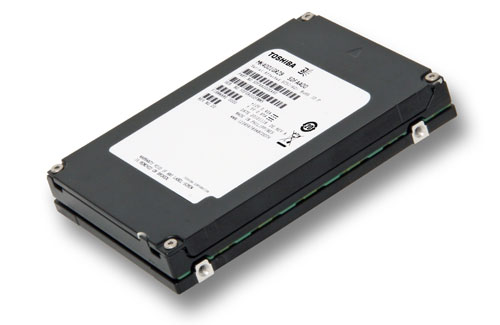Let’s get it out of the way, solid-state drives (SSDs) like Toshiba’s enterprise-class unit pictured above are expensive when you compare them to regular, magnetic hard drives. Old news, but it’s still a huge roadblock toward massive, widespread adoption. But those that are in the platter-free data storage camp are finding benefits that far outweigh huge sticker prices.
That’s the idea that sparked an interesting conversation at Slashdot yesterday. It all started with an article in Computerworld by Lucas Mearian. In it, he recounted the story of Dan Marbes, a systems engineer for Associated Bank in Green Bay, Wis.
Long story short, with the strategic installation of three SSDs, he saw a huge performance gain on a business intelligence apps on his SAN. How huge? “The flash storage outperformed 60 15,000-rpm Fibre Channel disk drives when it came to small-block reads.”
Pretty eye-opening in and of itself, but leave it to the Slashdot community to dig deeper and add some nuance, backed in some cases with real world experience, to the eternal SSD vs. HDD (hard disk drive) debate.
Here’s an example from user Raleel:
I moved a small 4TB database from 24x 256G 15k SAS drives to 24x 240G OCZ Vertex 3 SATA3 drives. I ran a few queries on the old and the new. same data, same parameters, same amount of data pulled. Both were hooked up via PCIe 8x slots.
The SSD crushed the SAS. Not just a mere 2x or 3x crushing. A _FIFTEEN TIMES FASTER_ crushing. This was pulling about a million rows out. 12 seconds (SSD) vs 189 seconds (spindles)
Cost difference? under $50 per drive more expensive for SSD. I think our actual rate was around $10 per drive more. However, the system as a whole (array+drives+computer) was $12k less. No contest… for our particular application, SSD hands down makes it actually work.
Counterpoint? Sure! Here’s a sobering analysis from user demonbug of Marbes’ experience as it relates to HDDs in certain use cases:
The only mildly surprising part is that part about the HDDs winning for all writes, but I guess that really depends on how the test is set up – unless you are actually writing to random parts of the HDD, it is basically a straight-up write operation, so only throughput matters – and again, 60x HDDs are going to beat 3x SSDs (though it is important to note that SSDs are significantly slower at writing than reading in general, although still much faster than an HDD on an individual basis).
It all underscores the point that SSDs have enormous benefits that justify their lofty prices. The performance boost and energy savings certainly help tip the scales in SSD’s favor. And judging by Raleel’s example, cost isn’t even a concern. But don’t make the mistake of counting hard drives out. At least, not yet.
Every organization has a unique set of storage requirements and implementations. And realistically speaking, the wholesale replacement of HDDs with SSDs is a non-starter. As the examples above show, the key to start enjoying the advantages of SSDs now is to start deploying them in parts of your storage infrastructure that play to their strengths.
To help you figure out how, I encourage you to hit up Slashdot’s thread on the topic for some enlightening insights from both sides of the fence.

